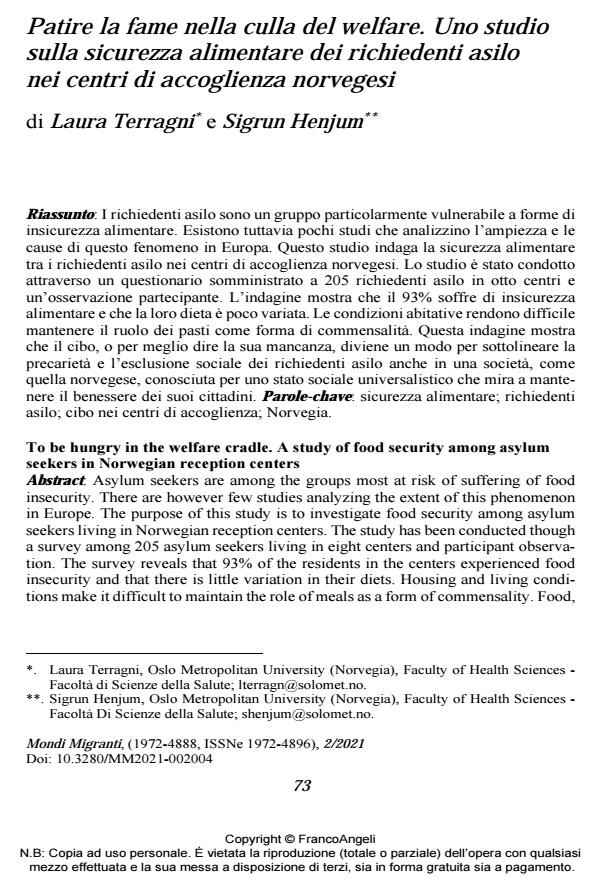Patire la fame nella culla del welfare. Uno studio sulla sicurezza alimentare dei richiedenti asilo nei centri di accoglienza norvegesi
Titolo Rivista MONDI MIGRANTI
Autori/Curatori Laura Terragni, Sigrun Henjum
Anno di pubblicazione 2021 Fascicolo 2021/2
Lingua Italiano Numero pagine 16 P. 73-88 Dimensione file 179 KB
DOI 10.3280/MM2021-002004
Il DOI è il codice a barre della proprietà intellettuale: per saperne di più
clicca qui
Qui sotto puoi vedere in anteprima la prima pagina di questo articolo.
Se questo articolo ti interessa, lo puoi acquistare (e scaricare in formato pdf) seguendo le facili indicazioni per acquistare il download credit. Acquista Download Credits per scaricare questo Articolo in formato PDF

FrancoAngeli è membro della Publishers International Linking Association, Inc (PILA)associazione indipendente e non profit per facilitare (attraverso i servizi tecnologici implementati da CrossRef.org) l’accesso degli studiosi ai contenuti digitali nelle pubblicazioni professionali e scientifiche
I richiedenti asilo sono un gruppo particolarmente vulnerabile a forme di insicurez-za alimentare. Esistono tuttavia pochi studi che analizzino l’ampiezza e le cause di questo fenomeno in Europa. Questo studio indaga la sicurezza alimentare tra i ri-chiedenti asilo nei centri di accoglienza norvegesi. Lo studio è stato condotto at-traverso un questionario somministrato a 205 richiedenti asilo in otto centri e un’osservazione partecipante. L’indagine mostra che il 93% soffre di insicurezza alimentare e che la loro dieta è poco variata. Le condizioni abitative rendono dif-ficile mantenere il ruolo dei pasti come forma di commensalità. Questa indagine mostra che il cibo, o per meglio dire la sua mancanza, diviene un modo per sottoli-neare la precarietà e l’esclusione sociale dei richiedenti asilo anche in una società, come quella norvegese, conosciuta per uno stato sociale universalistico che mira a mantenere il benessere dei suoi cittadini.
Parole chiave:sicurezza alimentare; ri-chiedenti asilo; cibo nei centri di accoglienza; Norvegia.
Laura Terragni, Sigrun Henjum, Patire la fame nella culla del welfare. Uno studio sulla sicurezza alimentare dei richiedenti asilo nei centri di accoglienza norvegesi in "MONDI MIGRANTI" 2/2021, pp 73-88, DOI: 10.3280/MM2021-002004